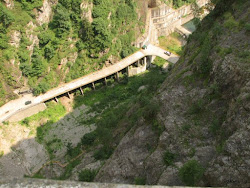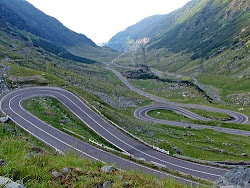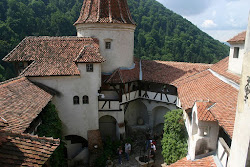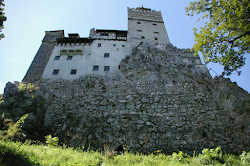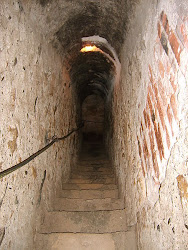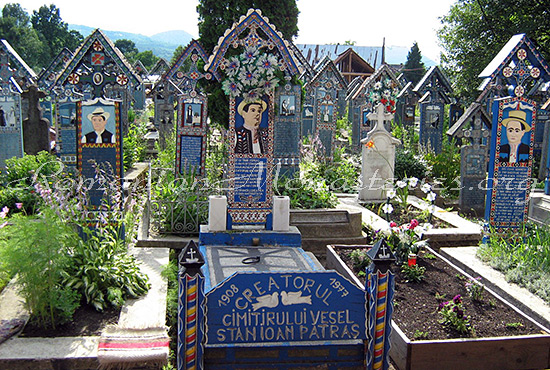 |
| The merry cemetery from Sapanta |
The worldwide fame of Sapânta is due to the unique cemetery that has become an important tourist attraction. Some days the throngs of tourists that assault the cemetery with their cameras ready make one wonder if it really is possible to rest in peace here!
The original character of the cemetery is first of all suggested by its name: Cimitirul Vesel that means The Merry Cemetery. This paradoxical name is due to the vivid colours of the crosses and the amusing or satirical epitaphs carved on them. It is said that this joyful attitude towards death is a legacy of the Dacians who believed in the immortality of the soul and that death was only a passage to a better life. They did not see death as a tragic end, but as a chance to meet with the supreme god, Zalmoxis.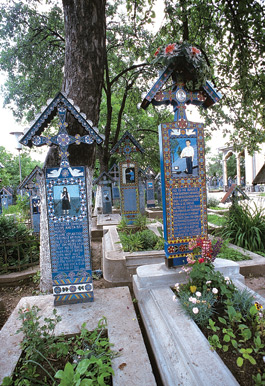 The cemetery dates back to the mid-1930′s and is the creation of the local folk artist Stan Ioan Patras, sculptor, painter and poet rolled in one. Patras used all his skills to create this masterpiece. For half a century the master created hundreds of wooden crosses, carved in a distinctive style, so famous today. After his death in 1977, his work has been carried out by his apprentice, Dumitru Pop Tincu.
The cemetery dates back to the mid-1930′s and is the creation of the local folk artist Stan Ioan Patras, sculptor, painter and poet rolled in one. Patras used all his skills to create this masterpiece. For half a century the master created hundreds of wooden crosses, carved in a distinctive style, so famous today. After his death in 1977, his work has been carried out by his apprentice, Dumitru Pop Tincu.The material used for the crosses is oak, which, after being properly cut and dried, is carved by hand. On the upper part of each cross is a bas-relief with a scene that describes the life of the deceased. The scenes are simple and naïve in style, but have an undeniable power: they bring back to life the inhabitants of the village and present their main occupation or a relevant aspect (either a virtue or a flaw) of their life. There are women spinning wool or weaving rugs, housewives baking bread, men cutting wood, farmers ploughing the land, shepherds tending their sheep, carpenters working the wood, musicians playing their instruments, butchers chopping lambs, teachers at their desks, alcoholics drinking, and so on.
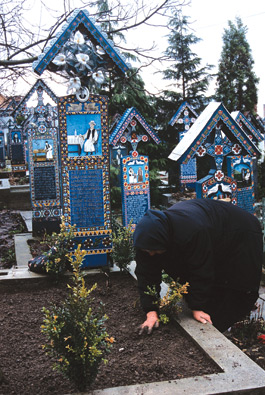 After the carving is done, the cross is painted. The background colour is a distinctive vivid blue, called “Sapânta blue“. Then the scene and the geometrical and floral decorations of the borders are painted with vibrant colours, yellow, red, white and green.
After the carving is done, the cross is painted. The background colour is a distinctive vivid blue, called “Sapânta blue“. Then the scene and the geometrical and floral decorations of the borders are painted with vibrant colours, yellow, red, white and green.One famous epitaph is:
Underneath this heavy cross
Lies my mother-in-law poor
Had she lived three days more
I would be here and she would read
You that are passing by
Try not to wake her up
For if she comes back home
She’ll bite my head off
But I will act in the way
That she will not return
Stay here my dear
Mother-in-law.
Other poems
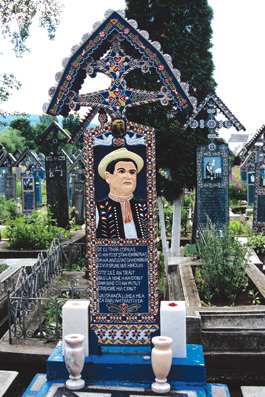 |
| The grave marker of Stan Ioan Patras, the creator of the Merry Cemetery |
Ever since a little boy
I was called Stan Ion Patras
Please listen to me good folks
What I say are not lies
All the days that I lived
I never wished ill for anyone
But all the good that I could
To whoever asked for it
Oh this poor world of mine
I was called Stan Ion Patras
Please listen to me good folks
What I say are not lies
All the days that I lived
I never wished ill for anyone
But all the good that I could
To whoever asked for it
Oh this poor world of mine
Other poems:
So hard was my life in it.
Here I rest
And Gheorghe Pop is my name
Like a handsome mountain fir
I was in my parents’ yard
Young and kind-hearted
There were not many like me in the village
When I finished the army
I bought myself a car
And the whole country I toured
Many friends I found
Many friends that were kind
The way I liked
When I was to live my youth
In the earth I rot.
With these images and the short poems, Stan Ioan Pătraş and Dumitru Pop Tincu have managed to recreate the entire village at the cemetery and give the people a second life beyond the grave. The more than 800 painted crosses constitute a vast archive that preserves, carved in wood, the stories of the people of Săpânţa.
